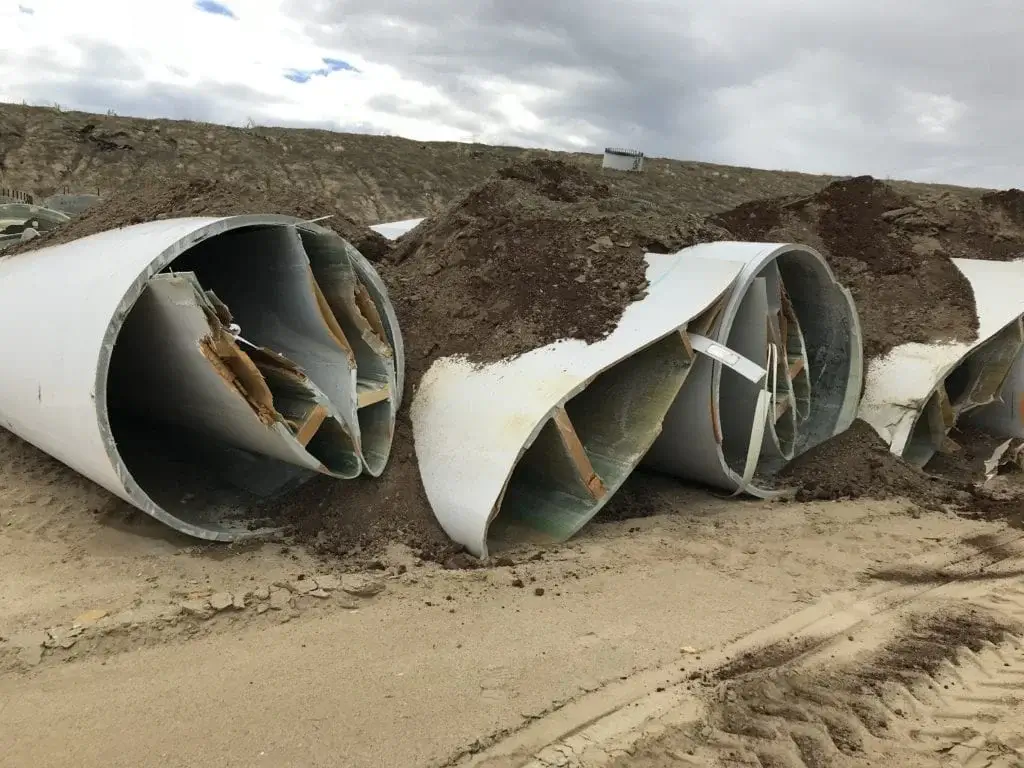
Modern wind energy converts the kinetic (motion) energy of the wind into mechanical energy. This is done by rotating large fiberglass arms, which then rotate a generator that generates electricity.
The mixed nature of the material of these components makes it difficult to separate the plastic from the fiberglass for reprocessing into workable fiberglass material . And the strength needed for the windmill blades means that tearing them apart is also physically difficult.
Some facts about wind farms and wind “gnarly” energy.
Wind turbines, can be located onshore or offshore and the turbine designs themselves have evolved over time, increasing in size and efficiency, eventually leading to greater generating capacity.
The basic design of today’s commercial turbines are horizontal-axis wind turbines consisting of a rotor with three blades, each made of fiberglass, reaching a hub, which itself is attached to a central part (nacelle) located on a steel tower.
Various other machinery and concrete foundations are also included in the design of modern wind turbines, which consist of more than 8,000 parts per turbine. Wind turbine blades are about 50 meters long on average, and with recent trends of using longer blades in larger turbines and taller towers to increase electricity production. Some of the largest blades currently in production reach 60-80 meters in length .
In terms of durability, wind turbines last about 25 years on average. About 85 percent of the turbine’s component materials-such as steel, copper wire, electronics and gears-can be recycled or reused.
The biggest challenge for recycling is the moving windmill blades, which are made of fiberglass (a composite material). As a result, they are lightweight to ensure performance, yet tough enough to withstand storms, temperature spikes as well as mechanical impacts.
What is the problem with windmill recycling?
The mixed nature of the material of these components makes it difficult to separate the plastic from the fiberglass for reprocessing into workable fiberglass material . And the strength needed for the windmill blades means that tearing them apart is also physically difficult.
Wind turbine blades need to be disposed of or recycled when turbines are decommissioned at the end-of-life stage or when wind farms are upgraded. This is a process known as”repowering,” which is the installation of more powerful turbines. Then, too, the blades can be replaced with more modern and usually larger and more energy-efficient ones.
Although it is possible to cut wind blades into several pieces on site, during the decommissioning or re-powering process, these parts are still difficult and expensive to transport for recycling or disposal. And the very process of cutting the blades with extremely powerful blades requires huge equipment. We are talking about equipment such as vehicle-mounted wire saws or diamond saws, similar to those used in quarries.
Because there are so few options for recycling blades these days, the vast majority of those that reach the end of their useful life are either landfilled in various locations, taken to landfills, or most often buried in desert areas as low-impact trash (turbine blades usually have no impact on the environment in which they are buried).
It is estimated that 14,000 wind turbine blades will be decommissioned in the next few years in Europe alone – so unless a proper method is developed to recycle them, we will end up burying them in the ground or dumping them in huge landfills.Several methods are currently being tested: Germany, for example, recycles turbine blades into cement – mechanical recycling, solvolysis and pyrolysis work. Attempts are also being made to use decommissioned blades in civil engineering projects as parts of structures or power line towers. Taking all this into account, certainly an interesting solution would be wood windmills but these are a rather distant concept for RES.
How does the world deal with recycling windmills and wind farms?
A key aspect of recycling composite materials is to ensure a positive outcome of the recycling process compared to the alternative of landfilling. One example comes from Germany, where the concept of recycling cement turbine wind blades was first developed about a decade ago at a plant built in partnership between Geocycle, a business unit of building materials corporation HolcimAG, and Zajons.
Another RES recycling option is the production of pellets or boards that can be used in carpentry applications. In 2019, Global Fiberglass Solutions began producing a product called EcoPoly Pellets in the US and will soon additionally produce a panelized version. These products are certified to be recycled from end-of-life wind turbine blades via radio frequency identification (RFID) from blade to final product. EcoPoly Pellets can be transformed into a variety of products, such as storage pallets, flooring material or parking posts. Several other major concerns are also developing other technologies, such as mechanical recycling, solvolysis and pyrolysis, which will ideally provide the industry with additional options for handling fiberglass blades once they are finished.
Some interesting solutions we are currently working on….
Lightief is currently working on a mobile semi-trailer with rope blades for cutting windmill blades at the site of demolition. This means lower transportation costs and will speed up their arrival at the final windmill recycling site.
A project is also underway to recycle the blades themselves, producing pellets and pellets and the possibility of commercial applications for the products obtained from this form of recycling. We are also working on a project to use elements of cut windmill blades for small architecture and construction (for example, for canopies of bicycle shelters, train and bus stops, elements of park architecture and children’s playgrounds).
Check also:
Recycling of photovoltaic panels
Process of receiving photovoltaic panels for recycling